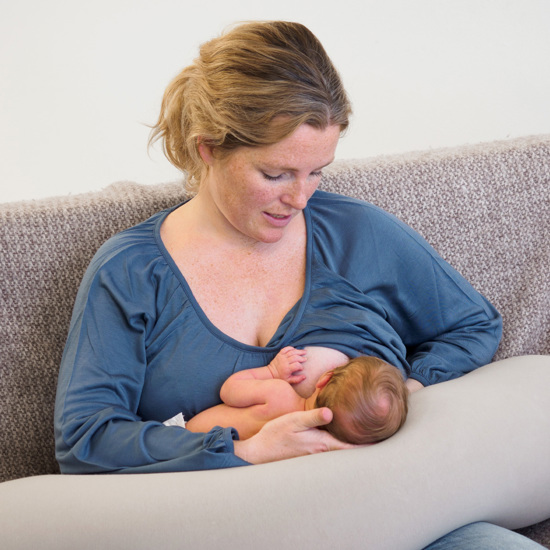Sore nipples – how can I get them to heal?
The best way of getting sore nipples to heal is to ensure that your baby gets a good latch. If you are struggling to get baby to latch on properly, ask your child health clinic for help. Cleanse any sores on your nipples daily using clean water, with no soap. Make sure your hands are clean and avoid touching your nipples directly. Good hygiene is important in preventing breast infection and inflammation (mastitis). There is no evidence that balms or salves aid healing, but a rich, thick-textured cream or ointment (intended for nursing mothers) around the sore can help relieve pain. A foam bandage can help the sore to heal and relieve pain. Alternatively, you can relieve sore nipples by manually expressing or pumping your milk.
Learn how you can help your baby latch on well
Sores on my nipples – what should I do if they do not heal?
Sometimes, sores on nipples are slow to heal. You should ask your child health clinic to check how well your baby is latching on. If baby is getting a good latch, but your sores are still not healing, they may be infected with bacteria and need treatment. To find out, you’ll need to have your nipple swabbed for bacteria. Ask your child health clinic or GP for help taking a bacterial sample. Sores should be cleansed daily using clean water, with no soap. Possible treatments include antiseptic cream or antibacterial ointment. Advice on treating sores (for healthcare professionals) is available from the website of the Norwegian National Advisory Unit on Breastfeeding (ammesenteret.no).
Large breasts – how can my baby get a good latch?
If you have large, heavy breasts, it can be difficult for your baby to latch correctly. A heavy breast can easily slip out of baby's mouth. If you have large breasts, it may be helpful to support your breast during feeds. Use a hand, or a towel rolled up and placed under your breast. As soon as baby opens wide over your breast, you can help by moulding your breast so she gets as much breast tissue as possible in her mouth. To do this, squeeze your breast gently so as to make it easier for baby to get plenty of breast in her mouth. You can continue to support your breast while breastfeeding.

Breastfeeding technique
Learn how you can help your baby latch on well
Illustration: Ole Walter Jacobsen - Helsedirektoratet
Blocked milk ducts – what should I do?
Your milk ducts may become blocked if your breasts are not drained often or sufficiently enough. This usually only happens on one side. You may feel one or more little lumps, which may be tender. The blockage may also affect a smaller or larger area of the breast. Continue breastfeeding and offer the painful breast first. Heat just before breastfeeding may help stimulate the milk flow. Try to reduce the swelling in your breast by applying cold compresses between breastfeeding sessions. You can also take Ibuprofen, if you tolerate it. Baby can drink your milk. Breastfeeding is generally the most effective way of draining your breasts. The area where the baby’s chin points often gets the best drainage. Vary your breastfeeding positions and make sure baby gets a good latch. Alternatively, you can express your milk by hand or using a pump. It may take a few days for the blockages to go away completely, but they should clear gradually.
Do I have mastitis?
Lactation mastitis can be bacterial or non-bacterial. In both cases, the breast may be red, hot, hard/swollen, painful and difficult to drain. Some mothers also have a fever and flu-like symptoms. Other conditions with similar symptoms are breast swelling, breast engorgement and blocked ducts. However, only bacterial mastitis requires antibiotic treatment. If you drain your breasts fully and get better fast (in 12-24 hours), it is most likely not mastitis. If draining your breasts does not help, and you feel poorly generally, then it may be mastitis. If you currently have or have had sores on your nipple, then it may be mastitis caused by bacteria. See your doctor to have your milk and any sores tested for bacteria.
How do I treat mastitis?
Mastitis with or without bacteria is basically treated in the same way, but bacterial mastitis may require antibiotics as well. Keep breastfeeding from the painful breast. Feeding your baby is the best way of emptying your breasts. The area where the baby’s chin points often gets the best drainage. Heat just before breastfeeding may make it easier to drain your breast. Alternatively, you can express your milk by hand or using a pump. Try to reduce the swelling in your breast by applying cold compresses between breastfeeding sessions. You can also take Ibuprofen, if you tolerate it. See if you get better within 12–24 hours. See a doctor if it doesn’t get better or gets worse. You will need rest and pain-relievers such as paracetamol and ibuprofen, if you tolerate them. Baby can drink your milk while you are taking the recommended antibiotics and pain-relievers.